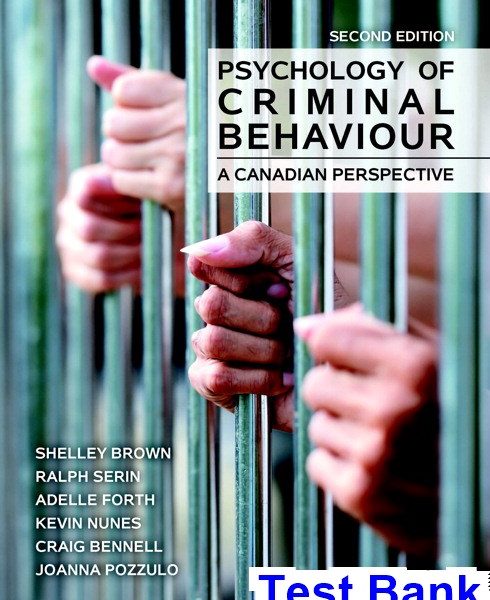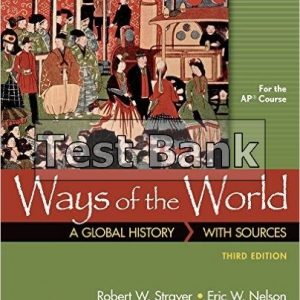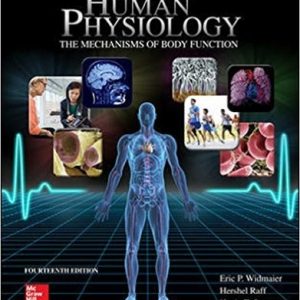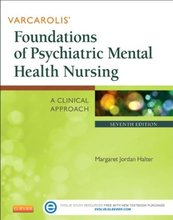Psychology of Criminal Behaviour A Canadian Perspective Canadian 2nd Edition Brown Test Bank

Product details:
- ISBN-10 : 0132980053
- ISBN-13 : 978-0132980050
- Author: Shelley Brown; Ralph Serin; Adelle Forth; Kevin Nunes
This Canadian text examines the intersection of criminal behaviour, the theory behind it, and the application of evidence-based practice to its study. It explores the Canadian criminal justice system, Canadian research and Canadian crime. Criminal Behaviour and Psychology is very accessible to students, and has a focus on empirical research to support key theories and practice. Contemporary themes are also highlighted to give this book a truly Canadian perspective.
Criminal Psychology, 2e is intended for use by Canadian students interested in studying the psychology of crime.
Table contents:
- Chapter 1 Crime in Canada
- Learning Objectives
- Context
- The Influence of the Media
- Definitions
- What Is Crime?
- Why do we Care?
- Federal and Provincial Corrections
- Career Profiles
- Correctional Officer (blended to reflect duties in both provincial and federal corrections)
- Parole Officer (federal, institutional)
- Probation Officer (similar to a federal parole officer in the community)
- Psychologist
- Professor
- A Career in Corrections
- Theories of Criminal Conduct
- What is Correctional Psychology?
- Crime Trends
- Crime Severity Index
- Crime Victimization
- Public Perceptions of the Criminal Justice System
- Variation in Crime by Source
- Length of Sentences
- Variations Across Provinces
- International Context
- Methodology
- Determinants of Crime
- Correlates, Risk Factors, and Causal Factors
- Factors Associated with Criminal Conduct
- Linking the Research to the Case Studies
- Future Directions
- Summary
- Discussion Questions
- Chapter 2 Theories of Crime: Biological and Evolutionary Explanations
- Learning Objectives
- Introduction
- Context
- Definitions
- Why do we Care?
- What Makes a Strong Theory?
- Methodology
- How Is Biology-Focused Research Conducted?
- Biological Theories of Crime
- Genetics and Crime—Twins, Adoption, and Molecular Genetics
- Twin Studies
- Adoption Studies
- Molecular Genetics Research
- Neurochemistry and Crime—Hormones and Neurotransmitters
- Hormones and Crime
- Neurotransmitters and Crime
- Psychophysiology and Crime
- The Brain and Crime—Neuroimaging and Neuropsychology
- Brain Imaging
- Neuropsychology
- Other Biological Considerations—Pregnancy, Birth Complications, Toxins, and Diet
- Evolutionary Theories of Crime
- Evolution 101: Natural Selection, Adaptation, and Beyond
- Methodology
- How Is Evolutionary Research Conducted?
- Evolution and Crime: What Do We Know?
- Life History Theory and Antisocial Behaviour
- Psychopathy
- Homicide
- Female-Perpetrated Crime
- Future Directions
- Summary
- Discussion Questions
- Chapter 3 Theories of Crime: Learning and Environment
- Learning Objectives
- Introduction
- Context
- Definitions
- Why do we Care?
- Methodology
- Psychodynamic Theories
- Basic Psychodynamic Principles: The Id, Ego, and Superego
- Psychodynamic Theories of Crime
- Bowlby’s Theory of Maternal Deprivation
- Unravelling Juvenile Delinquency: The Work of Glueck and Glueck
- Hirschi’s Control Theories
- Learning Theories and Crime
- Classical Conditioning
- Eysenck’s Biosocial Theory of Crime
- Operant Conditioning
- Principles of Operant Conditioning
- Application of Operant Conditioning Principles to Criminal Behaviour
- Social Learning Theories and Crime
- Sutherland’s Differential Association Theory
- Akers’ Social Learning Theory
- Andrews and Bonta’s Personal, Interpersonal, and Community-Reinforcement Theory
- Future Directions
- Summary
- Discussion Questions
- Chapter 4 Canadian Corrections in Practice
- Learning Objectives
- Introduction
- Context
- Why do we Care?
- What Happens When Someone Goes to Prison?
- Assessment Approaches and Effectiveness
- Risk Assessment
- General Recidivism Prediction
- Common Risk Instruments
- Key Decision Points Using Risk Assessment
- Pre-Trial
- Custody Classification
- Assessment Domains in Offender Classification
- Impact of Offender Classification
- Pre-Release
- Community Supervision and Dynamic Risk
- Using the Law to Change Criminal Behaviour
- Purposes of Sentencing
- Deterrence
- Using Correctional Psychology to Change Criminal Behaviour
- Model for Offender Change
- Restorative Justice
- Does Restorative Justice Work?
- Offender Rehabilitation
- What Does an Effective Program Look Like?
- Risk
- Criminogenic Need
- Responsivity
- Describing a Correctional Program
- Sample Program Content
- Program Evaluation and Accreditation
- Program Effectiveness
- Core Correctional Practice
- Future Directions
- Summary
- Discussion Questions
- Chapter 5 Adolescent Offenders
- Learning Objectives
- Introduction
- Context
- The History of Youth Justice in Canada
- Why do we Care?
- Youth Crime Rates-
- Youth Sentences
- Impact on Canadians
- Definitions
- Methodology
- Theories of Adolescent Offending
- Biological Theories
- Cognitive Theories
- Social Theories
- Factors Associated with Criminal Conduct among Adolescent Offenders
- What Do Canadian Youth Report?
- Protective Factors
- Assessment Approaches and Effectiveness
- Assessing the Under-12-Year-Old
- Rates of Behaviour Disorders in Children
- Assessing the Adolescent
- Risk Assessment Tools Used with Adolescent Offenders in Canada
- Adolescent Chemical Dependency Inventory (ACDI)—Corrections Version II
- Criminal Sentiments Scale (CSS)
- HCR-20
- Level of Service Inventory—Ontario Revised (LSI-OR)
- Offender Risk Assessment and Management System (ORAMS)
- Inmate Security Assessment (ISA)—Young Offenders
- Primary Risk Assessment (PRA)—Young Offenders
- Pride in Delinquency Scale (PID)
- Structured Assessment of Violence Risk in Youth (SAVRY)
- Youth Level of Service/Case Management Inventory (YLS/CMI)
- Youthful Offender—Level of Service Inventory (YO-LSI)
- Treatment Approaches and Effectiveness
- Primary Intervention Strategies
- Family-Oriented Strategies
- School-Oriented Strategies
- Community-Wide Strategies
- Secondary Intervention Strategies
- Tertiary Intervention Strategies
- Guiding Principles and Recommendations for Reducing Antisocial Behaviour
- Future Directions
- Summary
- Discussion Questions
- Chapter 6 Economically Motivated Offenders
- Learning Objectives
- Introduction
- Context
- Definitions
- Why do we Care?
- Methodology
- Categories of Economically Motivated Crime
- White-Collar Crime
- Profiling the White-Collar Criminal
- Profiling Victims of White-Collar Crime
- Public Perceptions of White-Collar Crime
- Theft
- Property Crime
- Fraud
- Identity Theft: A Special Case of Fraud
- Cybercrime
- Cyberbullying
- Prostitution
- The Male Client
- The Pimp
- Organized Crime
- Extent of Organized Crime in Canada
- How do Organized Crime Networks Operate?
- Organized Crime and the Sex Trade
- Organized Crime and the Drug Trade
- Organized Crime and Fraud
- Group Types in Organized Crime and Street Gangs
- Theories of Economically-Motivated Crime
- Explaining Property and Theft
- Explaining Fraud
- Explaining Cybercrime
- Explaining Prostitution
- Explaining the Drug Trade
- Explaining Gangs
- Factors Associated with Criminal Conduct among Economically-Motivated Offenders
- Property Crime
- Fraud and White-Collar Crime
- Cybercrime
- Prostitution
- Drug Trade
- Gangs
- Assessment Approaches and Effectiveness
- Property Crimes and Fraud
- Cybercrime
- Prostitution
- Drug Trade
- Gangs
- Treatment Approaches and Effectiveness
- White-Collar Crime Legislation
- Property Crime Interventions
- Fraud Interventions
- Cybercrime Interventions
- Prostitution Interventions
- Drug Trade Interventions
- Gang Interventions
- Future Directions
- Summary
- Discussion Questions
- Chapter 7 Substance Abusing Offenders
- Learning Objectives
- Introduction
- Context
- Definitions
- Why do we Care?
- Methodology
- Theories of Substance Abuse
- The Brain and Addictions—The Disease Model
- Genetics and Substance Abuse
- The Social Learning or “Choice” Model
- The Self-Medication Model
- Theories Explaining the Subtance Abuse/Crime Link
- Factors Associated with Crime Among Substance Abusing Individuals
- Type of Drug by Type of Crime: An Interaction Effect?
- Presence of Additional Risk Factors
- Protective Factors
- Assessment Approaches and Effectiveness
- Treatment Approaches and Effectiveness
- Legislation
- Drug Treatment Courts
- A Typical Corrections-Based Substance Abuse Treatment Program
- Methadone Maintenance Programs
- Do Corrections-Based Methadone Maintenance Programs Work?
- Motivational Interviewing
- Does Motivational Interviewing Work?
- Large-Scale Evaluations of Prison-Based Substance Abuse Programs
- Substance Abusing Programming within Correctional Service Canada (CSC)
- Does NSAP Work?
- Future Directions
- Summary
- Discussion Questions
- Chapter 8 Violent Offending: General Violence and Homicide
- Learning Objectives
- Introduction
- Context
- Definitions
- Reactive versus Instrumental Violence
- Homicide
- Multiple Murder: Definitions and Characteristics
- Terrorism
- Hate Crimes
- Why do we Care?
- Scope of Violence
- Offence Characteristics
- Impact on Victims
- Theories of Violent Offending
- Social Learning Theory
- General Aggression Model
- Evolutionary Psychological Perspective
- Methodology
- Factors Associated with Violence
- Assessment Approaches and Effectiveness
- Recidivism Rates
- Approaches
- Instruments
- Violence Risk Appraisal Guide-Revised (VRAG-R)
- HCR-20 Violence Risk Assessment Scheme
- Self-Appraisal Questionnaire (SAQ)
- Violent Extremist Risk Assessment (VERA)
- Accuracy
- Treatment Approaches and Effectiveness
- Effectiveness
- Future Directions
- Summary
- Discussion Questions
- Chapter 9 Intimate Partner Violence
- Learning Objectives
- Introduction
- Context
- Definitions
- Why do we Care?
- Prevalence and Nature of Intimate Partner Violence
- Male Victims of Intimate Violence
- Consequences of Intimate Partner Violence
- Typologies of Female Victims
- Triggers for Violence
- Victims’ Response to Abuse
- Methodology
- Studying Intimate Violence in the Lab
- Theories of Intimate Violence
- Factors Associated with Intimate Partner Violence
- Assessment Approaches and Effectiveness
- Treatment Approaches and Effectiveness
- Treatment: Which Treatment for Whom?
- Future Directions
- Summary
- Discussion Questions
- Chapter 10 Mentally Disordered Offenders
- Learning Objectives
- Introduction
- Context
- Definitions
- Mental Disorders and the Diagnostic and Statistical Manual (DSM)
- Unfit to Stand Trial (UFST)
- Not Criminally Responsible on Account of Mental Disorder (NCRMD)
- Why do we Care?
- The Effects of Deinstitutionalization on the Prison Population
- Mental Disorder and Stigma
- Prevalence of Mental Disorders among Offenders
- Prevalence of Personality Disorders
- Methodology
- Theories Linking Mental Disorder and Crime
- Symptoms of Mental Disorder that Increase Risk of Violence
- Factors Associated with Criminal Conduct among Mentally Disordered Offenders
- Mental Disorder: Associations with Crime, Violence, and Recidivism
- Protective Factors
- Assessment Approaches and Effectiveness
- Assessment of Mental Health Indicators
- Assessment of Risk of Suicide
- Assessment of Risk of Future Criminal and Violent Behaviour
- HCR-20
- Start
- SAPROF
- Treatment Approaches and Effectiveness
- Diversion
- Intervention
- Future Directions
- Summary
- Discussion Questions
- Chapter 11 Psychopathic Offenders
- Learning Objectives
- Introduction
- Context
- Definitions
- DSM: Changing Conceptualizations of Psychopathy
- Why do we Care?
- Prevalence of Psychopathy
- Survivors: The Impact of Being a Victim of a Psychopath
- Methodology
- Theories of Psychopathy
- Cognitive Models
- Developmental Models
- Genetics Models
- Brain-Based Models
- Assessment Approaches and Effectiveness
- Self-Report Methods
- Psychopathic Personality Inventory–Revised (PPI-R) (Lilienfeld and Widows 2005)
- Self-Report Psychopathy Scale (SRP-III) (Paulhus et al. forthcoming)
- Triarchic Psychopathy Measure (TriPM) (Patrick, Fowles, and Krueger 2009)
- Business Scan (B-Scan Self; B-Scan 360) (Babiak and Hare forthcoming)
- Rater-Based Methods
- Hare Psychopathy Checklist–Revised (PCL-R) (Hare 2003)
- Hare Psychopathy Checklist: Screening Version (PCL:SV) (Hart et al. 1995)
- The Dark Triad: Narcissism, Machiavellianism, and Psychopathy
- Assessing Psychopathy in Youth
- Youth Psychopathic Traits Inventory (YPI) (Andershed, Kerr, Stattin, and Levander 2002)
- Antisocial Process Screening Device (APSD) (Frick and Hare 2001)
- Hare Psychopathy Checklist: Youth Version (PCL:YV) (Forth, Kosson, and Hare 2003)
- Assessing Psychopathic Traits in Youth: Concerns
- Relationship between Psychopathy and Crime
- Treatment Approaches and Effectiveness
- Future Directions
- Summary
- Discussion Questions
- Chapter 12 Sexual Offenders
- Learning Objectives
- Introduction
- Context
- Definitions
- Why do we Care?
- Scope of Sexual Offending
- Consequences for Victims
- Theories of Sexual Offending
- Finkelhor’s Four Factor Model
- Evolutionary Explanation of Rape
- Seto’s Motivation–Facilitation Model of Child Sexual Offending
- Methodology
- Factors Associated with Sexual Offending
- Deviant Sexual Interests
- General Antisociality
- Childhood Sexual Abuse
- Beliefs Regarding Sexual Offending
- Emotional Congruence with Children
- Assessment Approaches and Effectiveness
- What About Dynamic Risk Factors?
- Violence Risk Scale—Sexual Offender Version (VRS-SO)
- Estimate of Risk of Adolescent Sexual Offense Recidivism (ERASOR)
- Treatment Approaches and Effectiveness
- Treatment Approaches
- Pharmacological Treatment
- Behavioural Treatment
- Cognitive-Behavioural Therapy
- Effectiveness
- Future Directions
- Summary
- Discussion Questions
- Chapter 13 Female Offenders
- Learning Objectives
- Introduction
- Context
- Definitions
- Why do we Care?
- Girls, Women, and Correctional Sanctions
- Prevalence and Nature of Female-Perpetrated Crime
- Understanding the Context of Female-Perpetrated Crime
- Methodology
- To Quantify or Qualify?
- Theories of Female Offending
- Feminist Pathways Perspective
- Personal, Interpersonal, and Community-Reinforcement (PIC–R) Theory
- Factors Associated with Female Offending
- Individual Risk Factors
- Criminal History
- Antisocial Personality and Impulsivity
- Criminal Attitudes
- Poor Self-Efficacy/Poor Self-Esteem/Disempowerment
- Poor Mental Health
- Substance Abuse
- Familial Risk Factors
- Childhood Maltreatment
- Negative Parental Factors
- Relational Risk Factors: Beyond Criminal Friends
- Relationships with Criminal Friends
- Negative Relationships with Intimate Partners
- Community/Structural Risk Factors
- Poor School Performance/Employment Difficulties
- Poor Community Functioning
- Economic Marginalization and Patriarchy
- Summary
- Protective Factors
- Assessment Approaches and Effectiveness
- Gender-Neutral Risk-Assessment Instruments
- Criticisms of Gender-Neutral Instruments
- Gender-Informed Risk Instrument
- Treatment Approaches and Effectiveness
- Canadian Approaches
- Global Developments
- Specific Treatment Targets
- Criticisms of the Gender-Neutral Correctional Treatment Model
- Future Directions
- Summary
- Discussion Questions
- Chapter 14 Aboriginal Offenders
- Learning Objectives
- Introduction
- Context
- Definitions
- Why do we Care?
- Methodology
- Theories of Aboriginal Overpresentation
- Potential Explanations of Aboriginal Overrepresentation
- Higher Aboriginal Offending Rates
- A Tendency to Commit More Violent Crime
- Discrimination in the Criminal Justice System
- The Socio-Economic Disadvantage of Aboriginal People
- Root Causes of Aboriginal Overrepresentation
- Attempts to Reduce Aboriginal Overrepresentation
- Factors Associated with Offending among Aboriginals
- Childhood Risk Factors
- Adult Risk Factors
- Assessment Approaches and Effectiveness
- Level of Service Inventory–Revised (LSI–R)
- Statistical Information on Recidivism (SIR) Scale
- Custody Rating Scale (CRS)
- Aboriginal-Specific Risk-Assessment Instruments
- Risk of Reoffending among Aboriginal and Non-Aboriginal Offenders
- Treatment Issues and Approaches
- The Treatment Needs of Aboriginal Offenders
- Aboriginal and Non-Aboriginal Treatment Programs
- Aboriginal Healing Lodges
- Does Paying Attention to Culture Matter?
- Future Directions
- Summary
- Discussion Questions
- References
- Name Index
- A
- B
- C
- D
- E
- F
- G
- H
- I
- J
- K
- L
- M
- N
- O
- P
- Q
- R
- S
- T
- U
- V
- W
- X
- Y
- Z
- Subject Index





